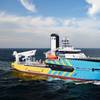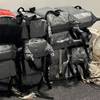SSC San Diego Researchers Selected as DON Top Scientists and Engineers
Six Space and Naval Warfare Systems Center (SSC) San Diego researchers were selected for the Department of the Navy Top Scientists and Engineers Program 2006, Sept. 7. Assistant Secretary of the Navy for Research, Development, and Acquisition Dr. Delores Etter selected Dr. Roy Axford and Jeff Waters for the category of "Top Scientists"; and Michael Thorpe, Estrellina Pacis, Dr. Richard Waters, and Dr. Joseph Neff for the "Top Emerging Investigators" category.
"This is wonderful news and a testament to your support of Department of the Navy objectives in the advancement of science, engineering, and technology," said Rear Adm. Mike Bachmann, Commander, Space and Naval Warfare Systems Command. Dr. Axford led a team of engineers in completing satellite communications testing for the Wideband Global Satellite Communications program using a new approach that exposed a major design flaw that would have prevented successful satellite deployment. Jeff Waters was recognized for his leadership and innovation in redesigning and implementing the Knowledge Web (Kweb). Kweb is a computer software system that gathers and assembles information from different sources to provide a perpetual briefing capability aboard the USS Carl Vinson (CVN 70).
Michael Thorpe is the engineering lead for the Recon Adaptive Patrol Tactical Robotic Sentry (RAPTRS) system prototype. RAPTRS is an unmanned ground vehicle that is capable of detecting and classifying intruders entering Navy-controlled locations. This roaming, sentry patrol is a practical alternative to using humans in operations with a potential risk of injury or loss of life. Estrellina Pacis manages the Robotics Technology Transfer Program, which expedites the fielding of robotics R&D products.
The Autonomous Robotic Mapping System consists of over 10 different components technologies that will be evaluated by the Marine Corps for operational use this fall 2007. This new capability will allow man-portable robots in the field to enter an unknown space such as a congested bunker or cave; explore and map its full extents; and search for items of tactical significance.
Dr. Richard Waters is the lead investigator for Micro-Electro-Mechanical System (MEMS) technology that can be applied to defense-related systems for navigation, chemical and biological detection, as well as energy harvesting. The MEMS navigation technology might one day provide a missile or unmanned aerial vehicle the navigational precision found in an F-18 today. Other applications of his MEMS technology provide for ultra-small chemical and biological sensors the size of a human hair as well as energy harvesting devices to power autonomous sensor nodes. Dr. Joseph Neff developed several custom microelectronnic circuits in support of team member efforts to develop a low power and compact magnetic field detector. The Army and The Marine Corps are testing this device for a variety of uses including unattended ground sensor applications.










